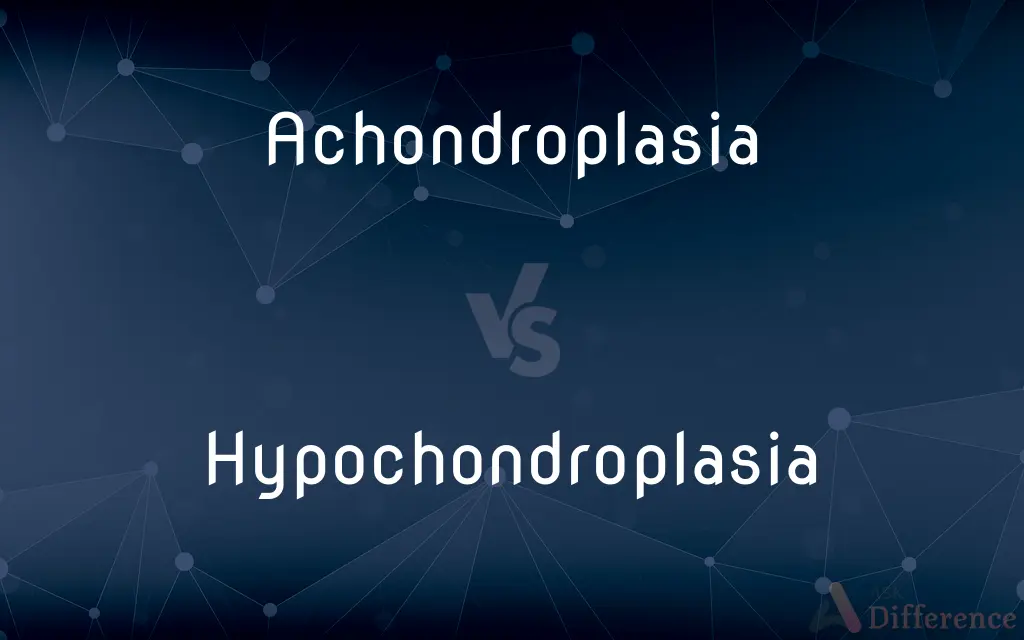Achondroplasia vs. Hypochondroplasia — What's the Difference?
Edited by Tayyaba Rehman — By Maham Liaqat — Updated on April 15, 2024
Achondroplasia and hypochondroplasia are both genetic disorders affecting bone growth, but achondroplasia is more severe, leading to a more pronounced dwarfism compared to the milder hypochondroplasia.

Difference Between Achondroplasia and Hypochondroplasia
Table of Contents
ADVERTISEMENT
Key Differences
Achondroplasia is characterized by a specific mutation in the FGFR3 gene that severely inhibits the growth of cartilage into bone, particularly in the arms and legs. Whereas, hypochondroplasia involves a similar but less severe mutation in the same gene, resulting in less dramatic shortening of the limbs.
Individuals with achondroplasia often have distinct facial features such as a prominent forehead and a flattened nasal bridge. On the other hand, these features are less pronounced in hypochondroplasia, making it less immediately recognizable.
In terms of height, adults with achondroplasia typically reach about 4 feet in height, with proportionally shorter arms and legs. While, those with hypochondroplasia are usually taller, generally reaching heights between 4 and 4.5 feet.
Health complications can be more severe in achondroplasia, including issues with spinal compression and breathing difficulties. Whereas, individuals with hypochondroplasia tend to experience fewer and less severe health issues related to their condition.
Diagnosis of achondroplasia can often be made prenatally due to the pronounced physical characteristics visible in ultrasounds. In contrast, hypochondroplasia may not be as easily detected until later in childhood due to its subtler manifestations.
ADVERTISEMENT
Comparison Chart
Genetic Mutation
Severe mutation in FGFR3 gene.
Less severe mutation in the same gene.
Physical Characteristics
Prominent forehead, flattened nasal bridge.
Less pronounced facial features.
Average Adult Height
Around 4 feet (122 cm).
4 to 4.5 feet (122 to 137 cm).
Health Complications
More severe, including spinal and breathing issues.
Generally milder complications.
Diagnosis Timing
Often prenatally or at birth due to distinct features.
Usually later in childhood due to subtler features.
Compare with Definitions
Achondroplasia
Most common form of short-limbed dwarfism.
Among dwarfism types, achondroplasia is the most frequently encountered in clinical settings.
Hypochondroplasia
Taller stature than achondroplasia.
Children with hypochondroplasia are typically taller than those with achondroplasia.
Achondroplasia
A genetic disorder resulting in dwarfism with specific skeletal abnormalities.
Achondroplasia is diagnosed through genetic testing confirming mutations in the FGFR3 gene.
Hypochondroplasia
Subtle facial features compared to achondroplasia.
His facial features subtly hint at hypochondroplasia, unlike the more pronounced signs of achondroplasia.
Achondroplasia
Associated with various orthopedic issues.
She undergoes regular check-ups for spine health due to her achondroplasia.
Hypochondroplasia
A milder form of skeletal dysplasia compared to achondroplasia.
Hypochondroplasia often goes undiagnosed until a child fails to reach common growth milestones.
Achondroplasia
Features include a larger head with a prominent brow.
His achondroplasia is evident in his facial structure and shorter limbs.
Hypochondroplasia
Fewer and less severe health complications.
Although she has hypochondroplasia, she experiences fewer health issues related to her condition.
Achondroplasia
Leads to characteristic body proportions.
Individuals with achondroplasia have a normal torso but shorter arms and legs.
Hypochondroplasia
Diagnosed usually in early childhood.
He was diagnosed with hypochondroplasia at the age of three after growth concerns arose.
Achondroplasia
Achondroplasia is a genetic disorder whose primary feature is dwarfism. In those with the condition, the arms and legs are short, while the torso is typically of normal length.
Hypochondroplasia
Hypochondroplasia (HCH) is a developmental disorder caused by an autosomal dominant genetic defect in the fibroblast growth factor receptor 3 gene (FGFR3) that results in a disproportionately short stature, micromelia and a head that appears large in comparison with the underdeveloped portions of the body. It is classified as short-limbed dwarfism.
Achondroplasia
Improper development of cartilage at the ends of the long bones, resulting in a form of congenital dwarfism.
Hypochondroplasia
(medicine) A mild form of achondroplasia.
Achondroplasia
(teratology) A genetic disorder, the most common form of short limb dwarfism.
Achondroplasia
A skeletal disorder beginning before birth; cartilage is converted to bone resulting in dwarfism.
Achondroplasia
An inherited skeletal disorder beginning before birth; cartilage is converted to bone resulting in dwarfism
Common Curiosities
What causes achondroplasia and hypochondroplasia?
Both are caused by mutations in the FGFR3 gene, which affect bone growth.
How are achondroplasia and hypochondroplasia diagnosed?
Diagnosis is typically through genetic testing and clinical evaluation of physical traits.
Are there any specific challenges children with these conditions face?
Children may face physical challenges and require interventions like surgery to manage spinal issues.
What are the reproductive implications for individuals with these conditions?
Individuals can reproduce, but there is a risk of passing on the mutation.
Is prenatal diagnosis possible for these conditions?
Yes, especially for achondroplasia due to distinct skeletal features identifiable via ultrasound.
How common is achondroplasia?
Achondroplasia is the most common form of disproportionate dwarfism.
What are the long-term outlooks for individuals with these conditions?
With proper medical care, individuals can lead full, productive lives.
Are there any new treatments on the horizon for these conditions?
Research is ongoing, including potential drug therapies that target the FGFR3 pathway.
Do achondroplasia and hypochondroplasia affect intelligence?
Intelligence is typically not affected by these conditions.
Can achondroplasia and hypochondroplasia be treated?
Treatment focuses on managing symptoms and complications; there is no cure for the genetic changes.
How do families typically cope with the diagnosis?
Support from healthcare providers and communities, including education and resources, is crucial.
How does the severity of symptoms vary between the two conditions?
Achondroplasia has more pronounced symptoms and complications compared to hypochondroplasia.
Can lifestyle changes help manage these conditions?
While lifestyle changes cannot alter the genetic aspect, they can help manage some symptoms.
Can adults with these conditions lead independent lives?
Yes, many adults with these conditions live independently, though adaptations may be necessary.
What is the role of genetics counseling in these conditions?
Genetic counseling is important for affected families to understand the conditions and reproductive risks.
Share Your Discovery

Previous Comparison
Compassion vs. Fairness
Next Comparison
Crane vs. CrankAuthor Spotlight
Written by
Maham LiaqatEdited by
Tayyaba RehmanTayyaba Rehman is a distinguished writer, currently serving as a primary contributor to askdifference.com. As a researcher in semantics and etymology, Tayyaba's passion for the complexity of languages and their distinctions has found a perfect home on the platform. Tayyaba delves into the intricacies of language, distinguishing between commonly confused words and phrases, thereby providing clarity for readers worldwide.














































